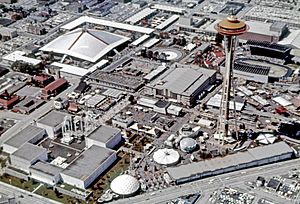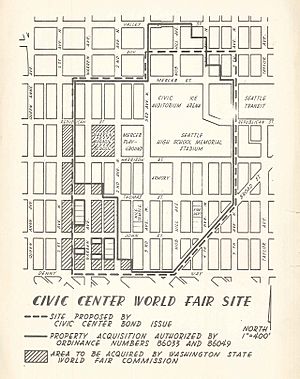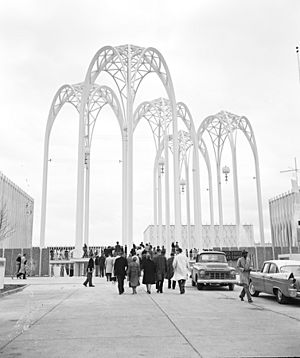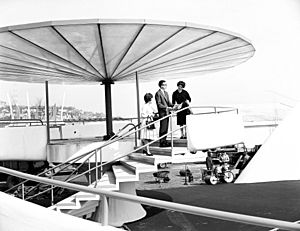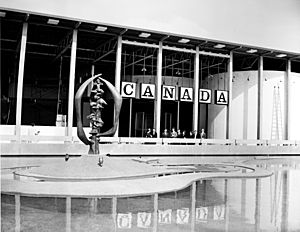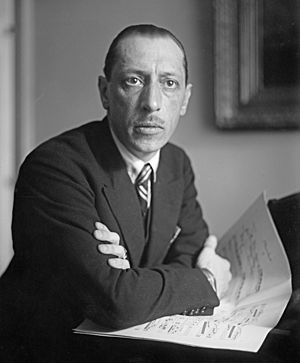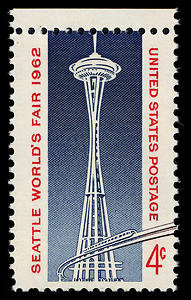Century 21 Exposition facts for kids
Quick facts for kids 1962 Seattle |
|
|---|---|

Century 21 Exposition logo
|
|
| Overview | |
| BIE-class | Universal exposition |
| Category | Second category General Exposition |
| Name | Century 21 Exposition |
| Motto | Living in the Space Age |
| Building | Space Needle |
| Area | 74 acres (30 hectares) |
| Invention(s) | Bubbleator, Friendship 7 |
| Visitors | 9,609,969 |
| Organized by | Edward E. Carlson |
| Participant(s) | |
| Countries | 24 |
| Location | |
| Country | United States |
| City | Seattle |
| Venue | Broad Street |
| Coordinates | 47°37′17″N 122°21′03″W / 47.62139°N 122.35083°W |
| Timeline | |
| Bidding | 1955 |
| Opening | April 21, 1962 |
| Closure | October 21, 1962 |
| Universal expositions | |
| Previous | Expo 58 in Brussels |
| Next | Expo 67 in Montreal |
The Century 21 Exposition, also known as the Seattle World's Fair, was a big event held in Seattle, Washington. It ran from April 21 to October 21, 1962. Almost 10 million people visited the fair during those six months.
This World's Fair was very successful. It left behind many public buildings and spaces that are still used today. Some people even say it helped Seattle's economy and culture grow a lot. Famous structures like the Space Needle and the Alweg monorail were built for the fair. Many sports and arts venues were also created. Unlike some other world's fairs, Century 21 actually made money!
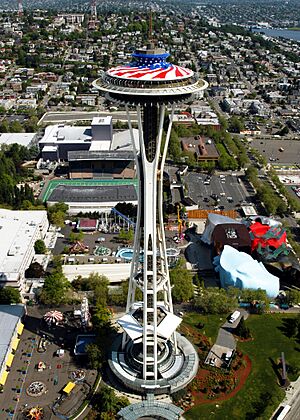
The fairgrounds are now called Seattle Center. The United States Science Pavilion from the fair is now the Pacific Science Center. Another cool building at Seattle Center, the Museum of Pop Culture, was built much later. It was designed to fit the fair's futuristic style.
Contents
Why Seattle Hosted the Fair
Seattle's mayor, Allan Pomeroy, helped bring the World's Fair to the city. In the early 1950s, he gathered leaders and started a petition. He wanted the city council to approve money for new buildings. These buildings, like an opera house and sports center, were needed to attract a big fair.
The city council eventually approved $7.5 million. The state of Washington matched that amount. This funding helped make the fair possible.
Space Race and the Future
The fair was first planned in 1955. It was meant to celebrate the 50th anniversary of an earlier fair in 1909. But that date was too soon.
At the time, the Space Race was happening between the U.S. and the Soviet Union. Boeing, a big aerospace company, was already in Seattle. So, the fair's main goal became showing that the U.S. was strong in science and space. The fair focused on space, science, and the future. It was less about the "American West" and more about what was next.
In 1960, the Bureau International des Expositions (BIE) officially recognized Century 21 as a World's Fair. The Soviet Union was invited but said no. Other countries like China, Vietnam, and North Korea were not invited.
The Cold War even affected the fair's closing. President John F. Kennedy was supposed to attend. But he had to cancel because he was dealing with a very important national event.
The fair showed a very hopeful view of the future. It imagined a world with lots of technology and wealth. It didn't really predict big social changes that would happen later in the 1960s. It focused on how humans would control nature with technology.
Fair Buildings and Grounds
Many places were considered for the fair in Seattle. The chosen spot was already planned to be a civic center. Using it for the fair brought in money from the government. This money helped build the United States Science Pavilion (now Pacific Science Center) and the Washington State Coliseum (now Climate Pledge Arena).
Some of the land for the fair was given to the city a long time ago. Other parts were bought from a church and a school. Old houses and buildings, some in poor condition, were torn down to make space.
The area had already been considered for a civic center since 1909. Some buildings like the Civic Auditorium (now McCaw Hall) and an ice arena were already there.
The fair planners also wanted to use two other nearby properties. They couldn't use Sacred Heart Church. But they did use the Freemasons' Nile Temple for the fair's Century 21 Club. This club offered special facilities for members. The city later bought this building, and it's now part of the Seattle Children's Theatre.
Paul Thiry was the main architect for the fair. He designed the Coliseum building. Minoru Yamasaki designed the United States Science Pavilion. He later designed the World Trade Center in New York. Victor Steinbrueck and John Graham, Jr. designed the famous Space Needle.
Even though the fair was meant to create a permanent civic center, many buildings were taken down after it ended.
The fairgrounds were divided into different themed areas:
- World of Science
- World of Century 21 (also called World of Tomorrow)
- World of Commerce and Industry
- World of Art
- World of Entertainment
- Show Street
- Gayway
- Boulevards of the World
- Exhibit Fair
- Food and Favors
- Food Circus
Besides the monorail, which still runs today, the fair also had a Skyride. This ride carried people in bucket-like cars high above the grounds. The Skyride was later moved to the Puyallup Fair.
World of Science Exhibits
The World of Science focused on the United States Science Exhibit. It also had a NASA Exhibit. This exhibit showed models of satellites and the Project Mercury capsule. This capsule had carried Alan Shepard into space. These exhibits were a big part of the U.S. government's contribution to the fair.
The Science Exhibit started with a short film called The House of Science. Then, visitors saw exhibits about how science developed. This included topics from math and astronomy to atomic science and genetics. The Spacearium was a special theater. Up to 750 people could take a simulated journey through our Solar System and the Milky Way Galaxy. Other exhibits looked at the scientific method and the future of science.
World of Century 21: The Future
The Washington State Coliseum was a key building in this area. It was designed to hold many exhibits and later become a sports arena.
Inside, nearly half the space was for the state's "Century 21—The Threshold and the Threat" exhibit. This was also known as the "World of Tomorrow" exhibit. It was a "21-minute tour of the future." The building also had exhibits from France, Pan American World Airways (Pan Am), General Motors (GM), and RCA.
In "The Threshold and the Threat," visitors rode a "Bubbleator" up into the "world of tomorrow." Music and lights created a special atmosphere. Then, they saw a model of a "city of the future," which looked like Seattle. This model showed the city by day and night.
The exhibit continued with a vision of a high-tech home and future transportation. This included a monorail and "air cars." There was also an "office of the future" and a "farm factory." The tour ended with a message about the future and a speech by President Kennedy.
Other exhibits in this building included a "library of the future" by the ALA. It featured a Univac computer. GM showed its ideas for future cars, like the Firebird III. Pan Am had a giant globe showing how quickly people could travel between cities. RCA showed off its TV, radio, and stereo technology.
World of Commerce and Industry
This area showed off businesses and products from the U.S. and other countries. It included the Space Needle and the area now known as the Broad Street Green.
One large building, the Interiors, Fashion, and Commerce Building, had exhibits from furniture companies to the Encyclopædia Britannica. Vogue magazine even put on fashion shows. The Ford Motor Company had a simulated space flight and showed its future car, the Ford Seattle-ite XXI. The Electric Power Pavilion had a tall fountain that looked like a hydroelectric dam.
Standard Oil of California celebrated that the world's first gas station opened in Seattle in 1907. The fair's Bell Telephone exhibit was even featured in a short film. There were also several religious pavilions. A large mosaic mural by Seattle artist Paul Horiuchi was also a highlight. It is now part of Seattle Center's Mural Amphitheater.
International exhibits included science and technology from Great Britain. Mexico and Peru showed handicrafts. Japan and India showed both their crafts and culture. Taiwan and South Korea showed their growing industries. There were also pavilions from Brazil, European countries, and newly independent African nations. Sweden showed a salvaged 17th-century warship. The DuPen Fountain, with sculptures by Everett DuPen, was also in this area.
World of Art Exhibits
The Fine Arts Pavilion (now the Exhibition Hall) had an amazing art show. It featured works by 50 modern American painters. These included famous artists like Jackson Pollock and Georgia O'Keeffe. Northwest painters like Kenneth Callahan were also featured. American sculptors like Alexander Calder were shown too.
Fifty international artists were also represented, including painters like Joan Miró and sculptors like Henry Moore. There were also special exhibits of Asian art and "masterpieces" from famous artists like Rembrandt and Picasso.
A separate gallery showed Northwest Coast Indian art. It included large paintings by Bill Holm that showed Native American designs.
World of Entertainment
The fair had a huge performing arts program. It included everything from boxing to international twirling. Many famous performers came to the new Opera House and Playhouse. After the fair, the Playhouse became the Seattle Repertory Theatre. It is now the Cornish Playhouse at Seattle Center.
Opera House Performances
The Opera House hosted many amazing acts:
| Date (all dates are 1962) | Act |
|---|---|
| April 21 | Opening Night: Seattle Symphony Orchestra with guest conductor Igor Stravinsky and soloist Van Cliburn |
| April 22–25 | The Ed Sullivan Show, live TV broadcasts |
| May 8–12 | The San Francisco Ballet |
| May 13 | Science Fiction Panel with Ray Bradbury and Rod Serling |
| May 24–25 | The Philadelphia Orchestra |
| May 29 – June 3 | The Old Vic Company (Shakespeare performances) |
| June 7, June 9, June 11 |
Seattle Symphony production of Verdi's Aida |
| July 9–14 | Bayanihan Dancers of the Philippines |
| July 24 – August 4 | New York City Ballet Company |
| August 27 – September 2 | Ballet Folklorico de Mexico |
| September 18–23 | D'Oyly Carte Opera Company (Gilbert and Sullivan operettas) |
| October 8–13 | Foo-Hsing Theater (Republic of China), youth Chinese opera |
Other Performances
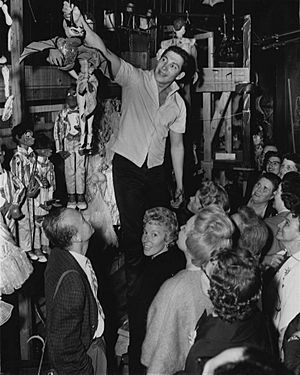
The Playhouse hosted Sweden's Royal Dramatic Theatre, chamber music, and appearances by newsman Edward R. Murrow. There was also Bunraku theater, Hal Holbrook as Mark Twain, and jazz orchestras like Count Basie's. Singers like Nat King Cole and Ella Fitzgerald also performed.
Memorial Stadium hosted the Ringling Brothers Circus, water ski shows, and a Western Show with Roy Rogers and Dale Evans.
The fair was also a setting for the Elvis Presley movie It Happened at the World's Fair (1963). A young Kurt Russell made his first movie appearance in it. The film was released after the fair ended.
Other Fun Sections of the Fair
- Gayway
- This was a small amusement park. After the fair, it became the Fun Forest. It had rides like the Flight to Mars, a dark ride about space pirates. Today, the Chihuly Garden and Glass is in its place.
- Boulevards of the World
- This was like the fair's shopping center. It also had the Plaza of the States and the first version of the International Fountain.
- Exhibit Fair
- Another shopping area under the north stands of Memorial Stadium.
- Food and Favors
- This section included all the restaurants and food stands across the fairgrounds. Options ranged from vending machines to the fancy Eye of the Needle restaurant atop the Space Needle.
- Food Circus
- This was a big food court in a former armory building. It's now called the Armory. It had 52 food vendors. After 1963, it also housed museums like Jones' Fantastic Show.
See also
 In Spanish: 21 Century Exposition para niños
In Spanish: 21 Century Exposition para niños


